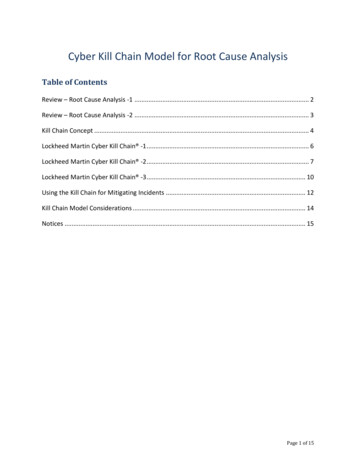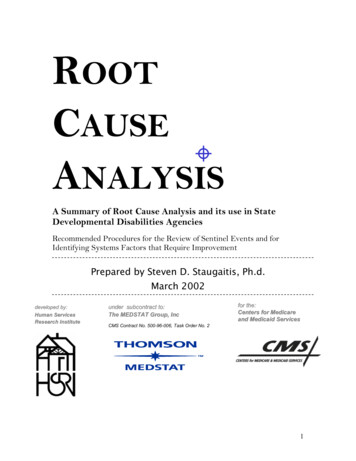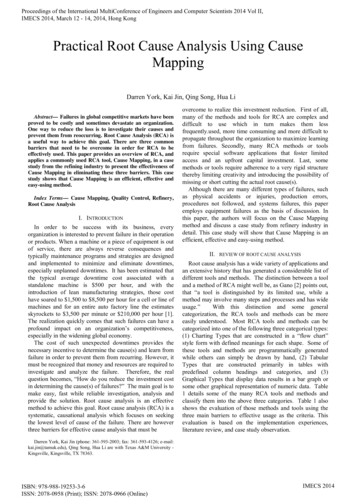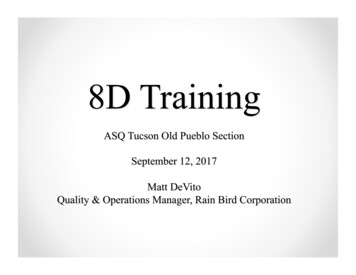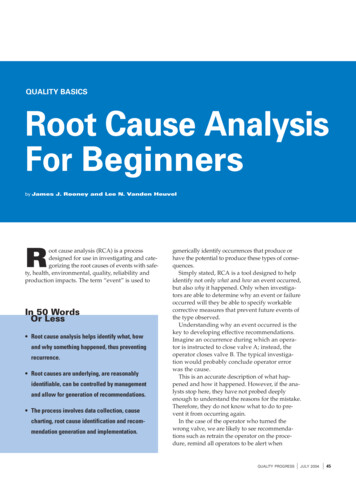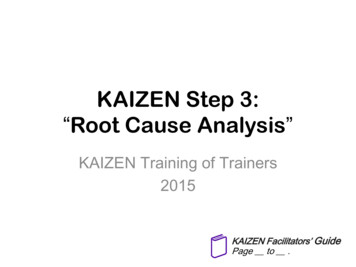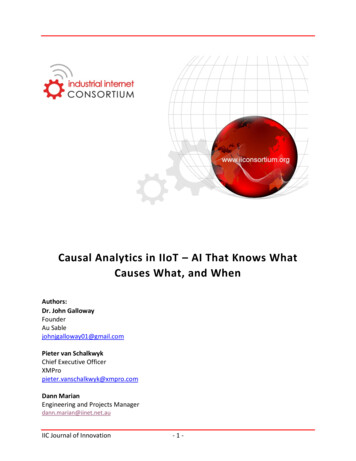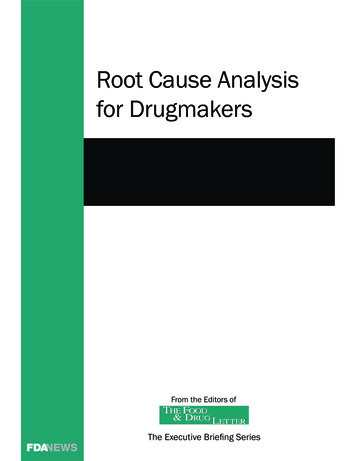
Transcription
Root Cause Analysisfor DrugmakersFoolproof Methods forValidation – 2013From the Editors ofThe Executive Briefing Series
Copyright 2013 by Washington Business Information Inc. All rights reserved. The Executive Briefing Series from The Food& Drug Letter (ISSN 0362-6466), is an in-depth analysis of regulations and issues affecting the pharmaceutical and biologicsindustries. The series is published monthly, 12 issues per year, for 4,995. Photocopying or reproducing in any form, including electronic or facsimile transmission, scanning or electronic storage is a violation of federal copyright law and is strictlyprohibited without the publisher’s express written permission. Subscribers registered with the Copyright Clearance Center(CCC) may reproduce articles for internal use only. For more information, contact CCC at www.copyright.com or call(978) 750-8400. For site licenses for multiple users or to purchase multiple copies, contact Nelly Valentin at (703) 538-7656.
Root Cause Analysis for DrugmakersTable of ContentsIntroductionDetermining Potential Product ImpactThe InvestigationRoot Cause Analysis5811RCA Tools12Tracking and Trending19Corrective and Preventive ActionKey Elements of the Investigation ReportFAQConclusionAppendicesAppendix A: An Overview of the RCA ProcessAppendix B: Analysis TechniquesAppendix C: Sample Causal Factor TreeAppendix D: Example Causal Factor ChartAppendix E: Claris Lifesciences Limited Warning Letter1720212324
IntroductionWhenever regulatory authorities anywhere in the world perform an audit of a drug manufacturer, one of their most frequent findings remains the inadequate performance of the investigationof deviations. Authorities expect stakeholders will carefully investigate deviations to identifynon-compliance, intervene and then evaluate the effectiveness of that intervention. Without adequate investigation and root cause analysis (RCA), those stakeholders cannot effectively identify and design successful interventions. In fact, organizations waste millions of dollars everyyear on ineffective interventions.A tool such as RCA uses a defined critical analysis approach in evaluating the reason for adeviation or nonconformance. As such, RCA represents an extremely helpful investigative toolin identifying why something continues to occur or, in the absence of any actual occurrence,why a firm might experience a series of near-misses. RCA techniques include brain storming,the “5 whys” and the “fishbone diagram.” Any and all may be used to explore and furtherexamine the causes behind an event. Firms may then use the resulting analysis to identify areasfor change, as well as any recommendations and solutions that aim to minimize the likelihoodof an event repeating in the future.While an RCA provides necessary feedback on an organization’s operational performance, italso costs it both in resources and time. For that reason, industry analysts recommend thatorganizations may choose to investigate only those events where they believe they have a significant amount to learn.Some organizations go so far as to create a corrective and preventive action (CAPA) for everyevent, although it is not always necessary. A firm’s primary goals in investigating an incidentshould include both discovering its cause and ensuring it does not reoccur. It is up to the firm,on each occasion, whether to take its investigation all the way back to the root cause or tomerely break the chain of events to halt the problem.Whether or not an organization conducts a full-blown RCA, it should track all deviations as tolocation, type, frequency and whether they are new or repeat events. In fact, industry expertsbelieve firms should track even those unexpected events not classified as deviations becausethey will yield valuable baseline information.Regulatory authorities place a high value on RCA and CAPA. Indeed, a large number of FDAobservations cite inadequate RCA, ineffective investigation and inappropriate CAPA. Thus,savvy organizations should want to improve their investigatory skills to remain in compliance.The following management report is based in part on a recent FDAnews webinar that featuredMichele Piepoli, managing director of MHP Consultants, LLC, a consulting organization withan emphasis on the pharmaceutical industry.4Root Cause Analysis for Drugmakers
Determining Potential Product ImpactWhen a deviation occurs, whether in the pharmaceutical or any other industry, the responsiblefirm must undertake an investigation to determine what went wrong and what damage, if any,the product might have suffered. The investigation process should include some specific steps.These include: Notification of the appropriate stakeholders; Classification of the event; Containment action;Decision to investigate;Determination of the root cause or RCA; andReview and approval process.The effectiveness of the CAPA taken by an organization marks another key step in the overallRCA. By monitoring the CAPA, an investigative team can determine whether it truly identifiedan incident’s root cause and then applied the “appropriate fix.” If it did not, it may find itselfback at square one and at the start of a new investigation.Immediate Action RequiredOne of the first things an organization should consider after an event occurs is the status of theproduct involved. The organization should determine whether the product remains within itscontrol or now resides outside in the marketplace. In the latter case, would that require quarantine or recall? Once the organization does identify the product’s status, it should then notify itsQA team and appropriate management personnel. These steps form a direct link to the RCA;organizations should approach them in a systematic way.An organization should take the following steps before launching an RCA. The steps will helpto clarify the event. They include: Interview personnel involved and gather the facts (who, what, where, when and how); Decide whether to convene the Material Review Board (MRB); Initiate a notification that the deviation has occurred;Conduct preliminary disposition of the product;Determine whether medical evaluation is required, if applicable; andConduct post-market surveillance.Furthermore, if an organization conducts an investigation as the result of a complaint, it shouldalso address any patient or consumer safety issues.Root Cause Analysis for Drugmakers5
Classifying the IncidentMost organizations have clearly defined criteria for how to classify an incident and when torequire an investigation. Certain scenarios may not require an investigation. The following classification levels chart can assist.Determining Classification LevelsLevelProduct ImpactProduct StatusDocumentation ErrorNoN/AMajorPotentialNot distributedMinorCriticalNoPotentialCAPA RequiredMandatoryUsing these classification levels, the spillage of bulk tablets during loading in packaging, resulting in the loss of 10 percent of a batch, might represent a minor deviation. A major deviationmight involve a corporate audit that reveals incomplete staff training for employees executing atask that did not result in release of bad product. And finally, an example of a critical deviationmight be represented by multiple occurrences in which laboratory analysts improperly verifieddata—which the FDA discovered during an inspection.Importance of InvestigationsWhy bother with a formal investigation? First, it satisfies a compliance requirement. Whether anorganization adheres to the FDA, EU regulations or ISO regulations, it must undertake an investigation in the event of an unplanned deviation. An organization may define the nature of theinvestigation, but it must perform one as a compliance responsibility.Secondly, organizations also have an economic responsibility to investigate. Conducting aninvestigation and determining the root cause of an incident can be expensive, but well worth it ifit can prevent future reoccurrence of similar deviations. And consider that chronic problems canpotentially hurt an organization in its market, especially if those problems result in any harm toconsumers.In short, a responsible firm must demonstrate due diligence. It must make sure it has left norock unturned in its hunt to determine the true root cause of an incident and how it affects theproduct in question. It must not simply seize upon the first potential cause of a problem that isrevealed and close its investigation if it hopes to retain its credibility with consumers.6Root Cause Analysis for Drugmakers
Furthermore, health regulatory authorities have begun citing organizations in ever growingnumbers for inadequate quality oversight. That has been the case especially in instances wherean organization invalidates out-of-specification test results without quality oversight, as well asin cases where RCA and CAPA prove inadequate (see Appendix E). Thus, organizations mustensure that they apply appropriate quality oversight to all procedures. Doing so helps assure ahigh-quality product.What FDA Regulations Address Root Cause Analysis Requirements?Drugs21 CFR 211.192Production record review.All drug product production and controlrecords, including those for packaging andlabeling, shall be reviewed and approved bythe quality control unit to determine compliance with all established, approved writtenprocedures before a batch is released ordistributed. Any unexplained discrepancy(including a percentage of theoretical yieldexceeding the maximum or minimumpercentages established in master productionand control records) or the failure of a batchor any of its components to meet any of itsspecifications shall be thoroughly investigated, whether or not the batch has already beendistributed. The investigation shall extend toother batches of the same drug product andother drug products that may have been associated with the specific failure or discrepancy. A written record of the investigation shallbe made and shall include the conclusionsand followup.Root Cause Analysis for DrugmakersDevices21 CFR 820.100Corrective and preventive action.(a) Each manufacturer shall establish andmaintain procedures for implementing corrective and preventive action. The proceduresshall include requirements for:.(2) Investigating the cause of nonconformities relating to product, processes, and thequality system;(3) Identifying the action(s) needed tocorrect and prevent recurrence of nonconforming product and other quality problems;.(7) Submitting relevant information onidentified quality problems, as well as corrective and preventive actions, for managementreview.(b) All activities required under this section,and their results, shall be documented.7
The InvestigationDuring the investigation process of an RCA, an organization must make all decisions by using a“risk-based” approach; it must determine the probability of a negative event and its consequences. It then should consider the impact or effect. Finally, it should make its decisions basedon those factors, not emotion or a desire to quickly resolve a problem. Throughout the investigation, the organization must continually ask: What are the consequences and the implicationsof each decision?Consider this example of a risk-based decision: The weather forecast calls for heavy rain andhigh winds. The authorities issue a recommendation to leave for higher ground because of thepotential for flooding. Residents must evaluate their risks and the potential impacts of the decisions they make. The potential impact or effects are: Loss of home (no control over it if flooding takes place); Loss of life (there is control if the person leaves for higher ground). Loss of belongings (some control because many items can be removed); andThe point here is that some things may be controlled and others may not, and risk should beassessed in determining what controls to impose.A Structured ProcessThe investigation process should be structured, but done so in a simple manner. It should consist of the following steps: Evaluate all currently available relevant information; Communicate with appropriate stakeholders; Interview appropriate people;Clearly define next steps;Decide if a “team” is needed; andDetermine the team’s makeup and leadership.The organization should fully analyze the situation before moving on and examining what factors contributed to the problem. To maximize an investigation’s effectiveness, the organizationshould gather everyone who understands the situation, including both high-level experts andfrontline staff. These individuals can help in understanding the event.As the investigation proceeds, the investigators should avoid becoming overwhelmed. Instead,they should stick to evaluating all the relevant information and following the investigation’sstructure. Investigators often find themselves pressured to rush an investigation by parties thatdemand answers and results. However, rushing an RCA can leave the true root cause undetermined.8Root Cause Analysis for Drugmakers
Strategy MeetingThe strategy meeting forms a key part of the investigation. The lead investigator must determine whether the meeting should be formal or informal and what it should accomplish. Theinvestigator also must decide who should participate; participants might include individualsfrom engineering, R&D, laboratory, production or QA. Certainly, the type of incident or deviation will help dictate attendance. As always, facilitation and focus both remain key to an effective meeting.The meeting should serve as a way to gather information by using the quantitative RCA toolcalled brainstorming (described in more detail later). Specifically, the meeting should addressboth issues of fact (what is known) and suspicion (potential root causes), yet take care to separate fact from opinion.During the meeting, team members must determine what additional information they requireand define the investigation’s next steps. The individual team members should resist the tendency to work on their own, in a “silo.” Unfortunately, such a tendency does arise when peoplemay grow defensive about their functional areas; nevertheless, an adequate investigation callsfor teamwork, with input and information from all impacted areas.Common MistakesThe investigation process can often fall victim to a number of common mistakes. The most frequently cited of these is the tendency of investigatory teams to jump to conclusions in theirhaste to find the root cause of an incident. They allow the conclusion to drive the data, ratherthan allowing the data to drive them to the appropriate conclusion.Another common mistake, as noted previously, is to allow individuals and departments eagerfor answers to rush the investigation. Other mistakes might occur when individuals unfamiliarwith the investigation process find themselves uncertain about how to proceed or even whatinformation to review. A final frequent mistake consists of ending an investigation too soon.It’s critical in an RCA to keep an open mind and focus on the facts. It may be tempting to relyon expertise and opinion. While both remain important, in the end only the facts of a given casewill provide the objective evidence that leads to the successful conclusion of an investigation.Using the Right ToolsThe investigatory team also must determine the appropriate tools to employ. The type of tooldepends on the specific type of approach the team intends to take. Examples include: Exploring and learning; Verifying and eliminating causes; Identifying potential causes;Analyzing a process; orAnalyzing data.Root Cause Analysis for Drugmakers9
For example, when a team explores an incident, it will learn about the process and thus shoulduse process-related tools for that phase of its inquiry. If it looks at data, it should use dataanalysis tools, such as charts and graphs. If the team’s objective is to generate potential causesand then hypothesize on the root cause, it should use qualitative tools, such as brainstorming orthe “5 whys.” And if the team’s objective is to eliminate causes while verifying the root cause,it should observe the process in action, conduct additional interviews with employees and follow the procedure through until it can eliminate each suspected cause. The next section explainsthese tools in much greater detail.10Root Cause Analysis for Drugmakers
Root Cause AnalysisAfter the team takes the preliminary investigation steps, it should then begin looking for theroot cause of the incident. Experience has shown RCA to be the best way to discover the underlying causes of undesirable events within an organization, through the use of a number of different tools, such as causal factor charts or fishbone diagrams, to name just two. RCA allowsthe opportunity to trace the progression of events that led up to the incident. In that sense, it ismuch like solving a crime.Data collection lies at the core of RCA. Data can be objective or subjective. They may consistof hard information (data and facts) or soft information (opinion, no data). For the purpose ofthe investigation, “facts” may be defined as something that may be measured or photographed—unlike opinions or judgments. Language such as “too much,” “insufficient,” or“poor” reflects opinions.Throughout an investigation, the team must occasionally take a step back and decide if it hasenough information on hand to warrant its moving forward. As previously noted, organizationscommonly yet mistakenly rush forward without really understanding what they have and whatthey still need. Some key points to keep in mind: Capture all necessary information; Be accurate, taking care to separate fact and conjecture. Do not yet discount any data or information; andRoot Cause Analysis for Drugmakers11
RCA ToolsAn RCA can involve the use of many tools. These might include brainstorming, process mapping, cause-and-effect, the “5 whys” and more. The important thing to remember about thesequantitative tools is that each is ineffective by itself, yet all are highly effective when usedtogether.Brainstorming remains probably one of the most popular tools in RCA. It is most effectivewhen used early in the process. The group meets and puts all the facts on the table, saying, “thisis what we know,” while continuing to look for any other potential root causes.While brainstorming represents a kind of free-for-all of ideas, it can and must be done in astructured way. Don’t dismiss anyone’s ideas during brainstorming. Indeed, the goal remains tocapture every possible idea, not challenge them individually. A team should refrain from making judgments during this process, given that it has not evaluated any data nor applied anyproblem-solving tools. After the team does gather all the necessary and pertinent information, itcan then evaluate and challenge that information.Process Mapping represents a visual representation of a process. It can be used as an analysistool when evaluating a process to uncover a potential root cause. For example, say a problemoccurs at step 32 of a manufacturing process, yet an in-process sample appeared within specifications. Then at step 62, someone identifies a problem. Thus, the investigation should focus onwhat happened between steps 31 and 62. Process mapping is an excellent way to break down,step-by-step, what could prove to be a contributing factor to a problem.Example of a Process (Flowchart)12Root Cause Analysis for Drugmakers
A process map might be compared to a recipe. Someone who bakes a cake that doesn’t turn outright might look back at the recipe and try to discover where things went wrong. Perhaps thebaker added only three eggs when the recipe called for four.Cause and Effect or Fishbone Diagram includes categories that vary depending on the scenario.“People” always represent one category on the diagram along with method, machine and material. All represent potential causes of the incident.Cause and Effect Diagram t Allowplentyof onroomonthe flip Allowplentyof roomthe flipchartMethodchartMachine Placethe problemstatementon the rightsiderightof thehanddiagram Placethe problemstatementon theside Placethe causeson theonmajorof the diagram Placethe causesthe categoriesmajor categoriesof the Post-It notes work well Post-It notes work wellof the diagramdiagramIncident reports often cite human error as the cause of an incident, yet unfortunately it tends tobe overused, according to industry experts. Instead, investigators should look beyond humanerror and take into account other factors. For example, employees may have received insufficient training or perhaps a batch record was not clear.Consider the following example: During an investigation into an incident, a requirement comesto light that analysts must have their test methods out on the bench while they prepare theirsamples. One analyst (let’s call her Mary) violated this requirement numerous times and, therefore, the team decided Mary represented the root cause of the incident. Why? Because shefailed to follow proper procedure.Subsequently, an investigator visited the lab and spoke with Mary. While there, the investigatornoticed the very small size of her workstation and those of her colleagues. The investigatorasked Mary to show her test methods, which had been sealed in binders in such a way that theycould not be removed. Indeed, to prepare her samples appropriately, Mary simply could notwork with her binder open on the bench. Furthermore, she had alerted her supervisor to theproblem, to no avail.Thus, Mary’s failure to follow procedures was not the root cause. Instead, it lay deeper thanthat. First, the environment made it virtually impossible for analysts to have the test method outon the bench while performing an assay. Second, Mary had discussed the problem with hersupervisor, who failed to act appropriately to solve the problem.While this represents a very basic example, the take-away point here is to always dig deeper.Root Cause Analysis for Drugmakers13
Those reviewing investigative reports must be willing to challenge conclusions just as if theyhad conducted the initial investigation.The fishbone diagram forces the investigator to evaluate all categories. The diagram should befilled out as shown in the example below.Cause and Effect Diagram (Fishbone)PeopleMaterialEnvironmentHigh Volume of SamplesOperators, EmployeesTrainersTraining MaterialsPrioritiesSupervisors, MgmtLocationInadequate Training ProceduresClassroom TrainingAge and TypeSOPs not clearMethodMachineNote how the “people” rubric, operators/employees represent one subcategory while supervisorsrepresent another. After completing the diagram, the investigative team should find itself withan outline for the investigation report it will write later.The “5 whys” method requires the investigator to start with a precise and focused problemstatement, then take the problem statement and ask “why” several times to get to the root of theproblem. The chart below illustrates how it can work.Why?Example: The “5 Whys”Why was Zone A contaminated by S. aureus?Why did operator cause contamination?Why was operator not present during training?Why was there no training follow up when hereturned from vacation?Why was there no procedure defined for follow up of missed trainings?Why was the SOP not updated according toQuality Module?14Answer and ObservationBecause operator caused contamination.Because operator was not present duringtraining regarding plant hygiene.Because operator was on vacation.Because there is no procedure defined forfollow up of missed training.Because the SOP was not updated accordingto Quality Module.Because there is no process established forthe rolling review of SOPs.Root Cause Analysis for Drugmakers
At first blush, it would appear the operator caused the contamination of Zone A after neglectingto obtain the appropriate training. On further investigation, and by asking “why” repeatedly, itappears that the organization had not put in place the appropriate procedures to ensure the operator received the proper training. The example once again points out how an investigation canjump to (incorrect) conclusions.Interestingly, the “5 whys” approach may be combined with another tool—brainstorming—insuch a way that results in out-of-the-box thinking. It also helps prevent anyone from jumping toeasy conclusions. Indeed, it creates an atmosphere that forces hard questioning. Furthermore, itkeeps the process moving until it starts uncovering objective evidence that will hold up to thescrutiny of regulatory authorities.Another RCA tool is Kepner Tregoe decision-making analysis, a structured methodology developed in the 1960s for gathering, prioritizing and evaluating information. The assessment andprioritizing of risk represents an important aspect of Kepner Tregoe decision-making. For thatreason, it fits well into the RCA. Here, the idea is not to find a perfect solution but rather thebest possible choice, based on achieving an outcome with minimal negative consequences. Itrepresents one way of making unbiased decisions because it limits those conscious and unconscious biases that draw attention away from the outcome.Below is an example of a KT matrix that shows how the methodology could be used to resolvea problem.The matrix analysis points an accusatory finger at the data restore done to the accounting department server on Friday afternoon. However, this should not mark the end of the analysis. The ideais to continue investigating and asking questions to come up with other possible causes.QuestionIsCould be, but is notWhere does ithappen?It is occurringon Bill’s computer and Fred’scomputer.It is not occurring onmy computerWhat is thedeviation?When did itstart?It is the fact thate-mail cannot beaccessed.Friday, at about2:00 p.m.Nothing else hasbeen observedDistinctionn/a Bill and Fred are in theaccounting department; I’mnot. The accounting departmentuses its own MS Exchangeserver, but I use a differentemail server;OK before that time.Root Cause Analysis for Drugmakers Bill and Fred do not log in assuper-user; I do.Partial restore done on accounting department server Fridaybetween 1:45 and 2:15 p.m.15
Qualitative ToolsAlong with the previously mentioned quantitative tools, qualitative tools also serve a veryimportant role in evaluating data. They include control charts, run charts, bar charts, histogramsand Pareto charts. All represent excellent tools for use in evaluating trends. Say, for example,one looks at the yield on a batch, over a span of 70 batches. Is there a pattern or trend overtime? Perhaps the yield did not change, but only now is starting to move to the lower range.These tools help identify any changes in the process, such as a new vendor, which could be thecause of the new pattern.Documenting DecisionsDocumenting the investigatory process represents another important part of the RCA. Theprocess must be understandable. That way, anyone reviewing the RCA can easily identify howthe root cause was determined. The task includes ensuring both due diligence and that all evidence supporting any conclusion is clearly stated. Auditors will grow frustrated if they must aska lot of questions in order to gain a true picture of what was done.The investigation report should document all activities, whether they are ultimately relevant ornot, conducted as part of the RCA . For example, if training records prove up to date and theoperator can demonstrate proficiency, the report should state that. That does not mean, however, that the report should be excessively long. The report should be complete, but strive to separate facts from either theory or opinion.16Root Cause Analysis for Drugmakers
Corrective and Preventive ActionCorrective and Preventive Action (CAPA) focuses on the investigation of deviations. It does soin an attempt to either prevent their recurrence or their occurrence in the first place. To ensurethe effectiveness of any corrective and preventive actions, organizations should continue monitoring them after the completion of the RCA and overall investigation.The most common CAPA-related audit observations include “inadequate—did not sufficientlyaddress root cause;” “inappropriate, did not address root cause;” “corrective and preventivewere not clearly defined;” and “not completed in the timeline identified.” One of the biggestpitfalls associated with CAPA occurs when someone assigns corrective and preventive actionswithout regard for resource requirement, capacity, ownership or timeline—in other words, without a plan.When it comes to CAPA, regulatory authorities expect organizations to ensure: The identified CAPA addresses the root cause; There is clear understanding of the overall impact of the CAPA; The solution can be implemented;Timelines and responsibilities (for implementation) have been reviewed and agreedto;There is a plan; andThere is a monitoring phase.If an organization makes it through the investigation and determines the root cause, that formsjust part of the equation. In the case of an inappropriate CAPA, further problems may ensue.Thus, the appropriate CAPA should be applied and monitored to ensure its effectiveness.FDA ObservationsThe below excerpt from a Warning Letter sent by the FDA to India’s Claris Lifesciences Ltd.illustrates the importance of CAPA to the agency. In the letter, the FDA cites Claris for failureto adequately perform an investigation after a deviation occurred (see Appendix E for the complete letter). Specifically, the company failed first to determine the status of its product and thenfailed to look for the root cause. Specific violations observed during the June 2010 inspection conducted at Claris Indiainclude, but are not limited, to the following:1. Your firm has failed to thoroughly investigate the failure of a batch or any of it
Root Cause Analysis for Drugmakers 5 DeterminingPotentialProductImpact Whenadeviationoccurs,wh
